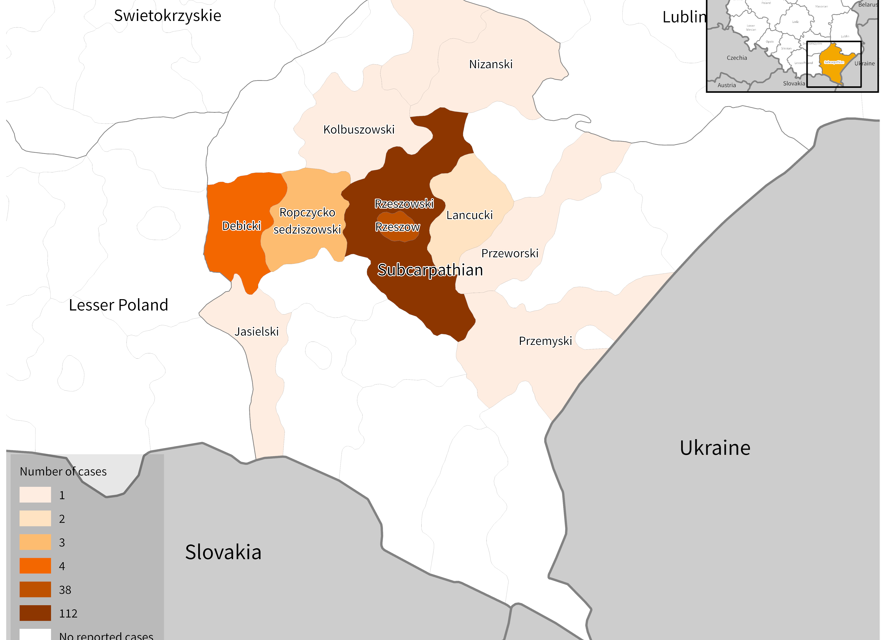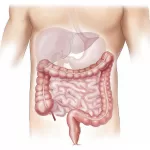Situation at a glance
As of 11 September 2023, a total of 166 cases of legionellosis, including 23 deaths, have been reported from Poland. Legionellosis, more commonly known as Legionnaires’ disease, is a pneumonia-like illness, caused by a bacterium, that varies in severity from mild to a severe illness and sometimes fatal form of pneumonia.
This observed increase in confirmed cases, and associated hospitalizations and deaths seen since mid-August, is unusual, considering that the number of cases is higher than the annual number reported in Poland since 2016.
Polish health authorities are coordinating cluster investigation activities, active case finding to identify additional cases, and public health activities to prevent transmission and limit the emergence of new cases, through preventive control measures. Since 7 September, no new cases have been reported, although the infection source has not yet been identified. Investigations are still ongoing to find the source of the outbreak.
Most people develop Legionnaires’ disease by inhaling the bacteria from water or soil. To date there has been no reported direct human-to-human transmission.
Description of the situation
On 18 August 2023, public health authorities in Rzeszów, Poland, announced the detection of a cluster of 158 suspected community-acquired pneumonia cases, including 15 laboratory-confirmed cases of legionellosis among patients admitted to several hospitals in Rzeszów.
Between 18 August and 11 September 2023, a total of 166 laboratory-confirmed cases, all hospitalized, and 23 associated deaths (CFR of 14%) have been reported. Most cases, 67% (n=112), were recorded in the city of Rzeszów, 23% (n=38) of cases in Rzeszów county, and 10% (n=16) cases in other locations.
Figure 1: Geographic distribution of confirmed Legionellosis cases in Poland between 18 August and 11 September 2023.

Preliminary results from an ongoing epidemiological investigation indicate that the first cases developed symptoms on 30 July, while most cases developed symptoms between 12-16 August. Adults between 60 and 90 years are the most affected age group. The most recently reported case has an onset date of 29 August. All 23 related deaths had underlying comorbidities and were between the ages of 53 and 98 (11 females and 12 males).
Figure 2: Number of confirmed Legionellosis cases reported in Rzeszow by Epidemic week
Laboratory results
Only hospitalized cases are tested for Legionella spp. The majority of the cases were confirmed through urine antigen tests and 11 cases were confirmed through respiratory samples by PCR. Culture and sequencing were not possible as the cases were treated with antibiotics.
Between 18 August to 11 September 2023, a total of 379 facility inspections were carried out. A total of 222 samples of hot and cold water were taken and investigations are ongoing.
Epidemiology of Legionellosis
Legionellosis is an infection caused by Legionella bacteria. The Legionella bacteria can cause a mild illness, Pontiac fever, non-pneumonic form of the disease, and Legionnaires’ disease, a severe pneumonia form of illness that can be fatal. Most people catch Legionnaires’ disease by inhaling the bacteria from water or soil.
Legionnaires’ disease, the pneumonic form, has an incubation period of 2 to 10 days (but up to 16 days have been recorded in some outbreaks). It is an important cause of community- and hospital-acquired pneumonia, and although uncommon, Legionnaires’ disease may cause outbreaks of public health significance. Initially, symptoms are fever, mild cough, loss of appetite, headache, malaise and lethargy, with some patients also experiencing muscle pain, diarrhoea and confusion. The severity of Legionnaires’ disease ranges from a mild cough to rapidly fatal pneumonia. Untreated Legionnaires’ disease usually worsens during the first week.
Mortality from Legionnaires’ disease depends on the severity of the disease, the use of antibiotic treatment, the setting where Legionella was acquired, and whether the patient has underlying conditions, including immunosuppression. The death rate may be as high as 40–80% in untreated immunosuppressed patients and can be reduced to 5–30% through appropriate case management, depending on the severity of the clinical signs and symptoms. Overall, the death rate is usually between 5–10%.
Public health response
- Meetings of the crisis staff at the Mayor of Rzeszów are held daily.
- Water samples were collected from the water supply system, residences of the sick, healthcare facilities, cooling towers, and installations in buildings located in Rzeszów, the Rzeszów poviat, and the Ropczyce and Sędziszów poviat.
- An epidemiological investigation, including interviews with patients or relatives, is underway to determine the source of infection.
- Mapping all positive cases, water sampling sites, and cooling towers is underway.
- Public fountains, public water sprays, and other public water sources have been shut down temporarily.
- Rzeszów Municipal Water and Sewage Company carried out the routine disinfection of the water supply in the city of Rzeszów and adjacent towns on 27 August 2023.
- Health care units and long-term care facilities have been instructed to carry out additional inspections of their water systems.
- Public health advice has been developed and shared across multiple channels.
WHO risk assessment
Legionellosis varies in severity from a mild febrile illness to a severe and sometimes fatal form of pneumonia and is caused by exposure to Legionella species found in contaminated water and potting mixes. Outbreaks of Legionella have been linked to poorly maintained water systems, particularly cooling towers or evaporative condensers associated with air conditioning and industrial cooling, hot and cold-water systems in public and private buildings, and whirlpool spas.
Infection can also occur by aspiration of contaminated water or ice, particularly in susceptible hospital patients. To date, there is no reported human-to-human transmission. Legionnaires’ disease requires treatment with antibiotics, and currently, no vaccine is available for Legionnaires’ disease.
Sporadic outbreaks of Legionnaires’ disease have been reported previously in Poland. Between 2017 and 2021, Poland reported between 38 to 74 cases of Legionnaires’ disease annually to the European Surveillance System (TESSy). In 2022, this increased to 111 reported cases.
Robust surveillance and response activities are being implemented during the current outbreak, and case numbers have been reduced. Nonetheless, without an identified source of Legionella bacteria, there is a continued risk of developing Legionellosis for people working or living in the affected areas. Older adults, smokers, and people with weakened immune systems are particularly susceptible to the disease.
Travel-associated Legionnaires’ disease (TALD) is a frequent phenomenon, with, on average, about 20% of the cases of legionellosis detected in Europe considered to be travel-associated. The outbreak is reported in the south-eastern city of Rzeszów, the main hub for humanitarian aid for Ukraine and the transit hub for international military support for Ukraine; therefore, TALD may be expected in people visiting Rzeszów.
According to the European Center for Disease Prevention and Control (ECDC), in 2021, the EU/EEA witnessed the highest annual notification rate of Legionnaires’ disease, with 2.4 cases per 100 000 population. The cause of the increased reported incidence observed during that period in Europe remains unclear. Legionnaires’ disease is a notifiable disease in the EU, and the events are closely followed up through ECDC and European Legionnaires’ Disease Surveillance Network (ELDSNet).
WHO advice
WHO recommends the continuation of laboratory analyses, case identification and clinical care, contact tracing, outbreak investigation to identify the source(s), implementation of measures to prevent further infections, and enhancement of Infection, Prevention and Control (IPC) measures. IPC measures in health facilities have been enhanced during the COVID-19 pandemic and should be reinforced to prevent healthcare-associated transmission, including measures to control waterborne pathogens. WHO does not recommend any specific different measures for travellers. In case of symptoms suggestive of respiratory illness during or after travel, travellers are encouraged to seek medical attention and share their travel history with their healthcare provider. Countries with Legionella cases reported after travel to Poland should notify their regional IHR focal points.
WHO advises against applying any travel or trade restrictions on Poland based on the current information available on this event.
Further information
- World Health Organization, Legionella and the prevention of legionellosis
- World Health Organization, Legionellosis fact sheet
- World Health Organization, Legionellosis Outbreak Toolbox
- World Health Organization, Guidelines for drinking-water quality, fourth edition incorporating the first and second addenda
- ECDC. Legionnaires’ disease – Annual Epidemiological Report for 2021
- Announcement of the State Poviat Sanitary Inspector in Rzeszów, Poland
- Legionnaires’ disease, Annual Epidemiological Report for 2021
- Case definitions, Official Journal of the European Union
- Surveillance Atlas of Infectious Diseases
Citable reference: World Health Organization (14 September 2023). Disease Outbreak News; Legionellosis in Poland. Available at: https://www.who.int/emergencies/disease-outbreak-news/item/2023-DON487













